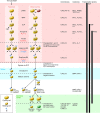Checkpoints that control B cell development
- PMID: 25938781
- PMCID: PMC4497745
- DOI: 10.1172/JCI78083
Checkpoints that control B cell development
Abstract
B cells differentiate from pluripotent hematopoietic stem cells (pHSCs) in a series of distinct stages. During early embryonic development, pHSCs migrate into the fetal liver, where they develop and mature to B cells in a transient wave, which preferentially populates epithelia and lung as well as gut-associated lymphoid tissues. This is followed by continuous B cell development throughout life in the bone marrow to immature B cells that migrate to secondary lymphoid tissues, where they mature. At early stages of development, before B cell maturation, the gene loci encoding the heavy and light chains of immunoglobulin that determine the B cell receptor composition undergo stepwise rearrangements of variable region-encoding gene segments. Throughout life, these gene rearrangements continuously generate B cell repertoires capable of recognizing a plethora of self-antigens and non-self-antigens. The microenvironment in which these B cell repertoires develop provide signaling molecules that play critical roles in promoting gene rearrangements, proliferation, survival, or apoptosis, and that help to distinguish self-reactive from non-self-reactive B cells at four distinct checkpoints. This refinement of the B cell repertoire directly contributes to immunity, and defects in the process contribute to autoimmune disease.
Figures

References
-
- Rolink AG, Schaniel C, Busslinger M, Nutt SL, Melchers F. Fidelity and infidelity in commitment to B-lymphocyte lineage development. Immunol Rev. 2000;175:104–111. - PubMed
-
- Melchers F, et al. Repertoire selection by pre-B-cell receptors and B-cell receptors, and genetic control of B-cell development from immature to mature B cells. Immunol Rev. 2000;175:33–46. - PubMed
Publication types
MeSH terms
Substances
LinkOut - more resources
Full Text Sources
Other Literature Sources
Medical

